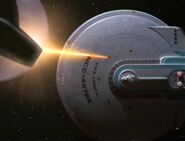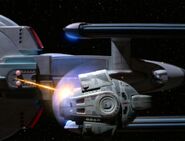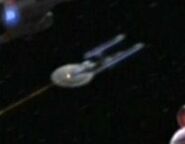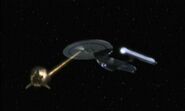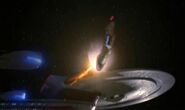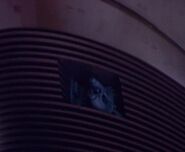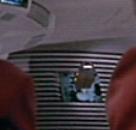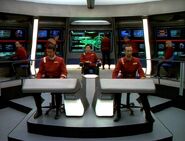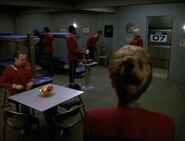The Excelsior class was a type of Federation starship used by Starfleet from the late 23rd century through the late 24th century.
History
The Excelsior-class was initially constructed during the early 2280s at Starfleet's San Francisco Fleet Yards orbiting Earth. (Star Trek VI: The Undiscovered Country dedication plaque)
Starfleet had high hopes for the first ship of this class, the prototype USS Excelsior, which was equipped with transwarp drive, and was regarded as that century's "Great Experiment." (Star Trek III: The Search for Spock)
- See: Trial runs for more concise details of the USS Excelsior's early history.
Despite the failure of the "Great Experiment," Starfleet forged ahead with employing the Excelsior design. After remaining in Earth Spacedock until at least 2287, the prototype Excelsior was subsequently recommissioned for active service by 2290. (Star Trek IV: The Voyage Home, Star Trek V: The Final Frontier, Star Trek VI: The Undiscovered Country)

USS Enterprise-B in drydock
In 2293, the fate of the Excelsior design was sealed when Starfleet passed on the name of a legacy. The launch of the USS Enterprise-B opened the door for the Excelsior class to become one of the most widely used designs in all of Starfleet, a design lasting well into the late 24th century. (Star Trek VI: The Undiscovered Country, Star Trek Generations, TNG: "Encounter at Farpoint" – VOY: "Endgame")
- According to the Star Trek: The Next Generation Technical Manual, the Enterprise-B was launched from Starfleet's Antares Ship Yards. The Technical Manual further explained that: "'Although the decision to model [the Enterprise-B] on the failed original experimental Excelsior was at the time controversial, the economics of using the existing (and otherwise successful) engineering of the basic spaceframe were compelling.'"

Alongside a Template:ShipClass starship
Once fully integrated into the fleet, the Excelsior's sister ships were used for a variety of mission profiles, ranging from deep space exploration and terraforming missions, to patrol duty, to courier and transport runs. (Star Trek VI: The Undiscovered Country; TNG: "Tin Man", "The Drumhead", "Brothers", "Allegiance"; DS9: "Homefront", "For the Uniform", etc.) The Excelsior-class was also frequently used by the Starfleet admiralty for use as a personal flagship. (TNG: "The Offspring", "The Best of Both Worlds", "Chain of Command, Part I", "Descent", "Preemptive Strike")
The Excelsior-class was present in several major Federation engagements, including the Borg invasion of 2366-2367, where it participated at the Battle of Wolf 359, as well as the engagement against the Borg sphere that entered the Sol system in 2377. (DS9: "Emissary"; VOY: "Unity", "Endgame") They were also present in numerous Dominion War battles, seeing action during Operation Return, the First and Second Battles of Chin'toka, and the Battle of Cardassia. Many Excelsior-class vessels were stationed near Deep Space 9 during the war. (DS9: "Sacrifice of Angels", "Tears of the Prophets", "The Changing Face of Evil", "What You Leave Behind", etc.)
Knowledge of this class would be retained well into the 31st century, when Captain Jonathan Archer and Lieutenant Malcolm Reed viewed schematics on the class in the 22nd century while accessing the database belonging to temporal agent Daniels. (ENT: "Shockwave")
Technical data
Physical arrangement
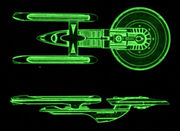
Profile and overview of the Excelsior
The Excelsior-class featured the saucer section-engineering section-warp nacelle layout common to most Starfleet vessels. However, it featured a more streamlined design than was seen in previous classes.
Port-side docking port
Design features of the primary hull included a docking port located on the port side of the hull. (DS9: "Chrysalis")
Design upgrades
Following its initial, and somewhat unsuccessful origins, the Excelsior underwent a minor refit, which included a new bridge module, in addition to a significant modification to the aft portion of the saucer section, surrounding the impulse drive, and a modification to the cargo bay on the aft ventral portion of the ship. (Star Trek VI: The Undiscovered Country)

The USS Enterprise-B, featuring additional impulse engines (top) and additional scoop surrounding the deflector dish (bottom).
In less than a decade, the Excelsior design underwent a second, more significant overhaul, as introduced with the launch of the Enterprise-B. While remaining true to the original configuration, several modifications to the basic hull design were made, including the addition of a second pair of impulse engines, expanded scoop surrounding the deflector dish, and the addition and removal of a number of fins located on the saucer and nacelles. (Star Trek Generations; DS9: "Paradise Lost")
- According to the Star Trek: The Next Generation Sketchbook: The Movies, the additional impulse engines were added to provide the ship with stronger engines, which would be needed when the saucer detached. This corresponds with the inclusion of a battle bridge on MSD appearing on the Enterprise-B bridge in Generations.
As this class aged, Starfleet continued to incorporate the latest technology, through continued upgrades, refits and repairs, well into the 2360s and 2370s. In 2364, the USS Melbourne underwent significant repairs at Starbase 74, while in 2367 the USS Hood underwent a major system upgrade at Starbase 174. (TNG: "11001001", "Brothers", etc.)
Tactical systems
The original Excelsior design was outfitted with 5 dual phaser emplacements on the forward saucer section, and one dual emplacement on the aft of the saucer. Phaser emplacements were also positioned laterally, located port and starboard, near the point that the primary and secondary hulls meet, as well as one emplacement located between the nacelles. (Star Trek VI: The Undiscovered Country, Star Trek Generations production art, DS9: "Paradise Lost", etc.)
In addition, the Excelsior was equipped with two forward and two aft photon torpedo launchers. Located in the forward section, above the deflector dish, were additional port and starboard torpedo launchers, which were capable of retracting into the ship and taking in craft up to the size of a workbee. (Star Trek VI: The Undiscovered Country, Star Trek Generations production art)
With the impending threat of the Dominion against the Federation, Starfleet began to experiment, in 2372, with performing a refit on the Excelsior-class USS Lakota. Upgrades included improved phaser emplacements, quantum torpedoes, and other improvements to make the ship competitive with such ship designs as the Template:ShipClass. (DS9: "Paradise Lost")
Propulsion systems
Transwarp drive – in theory.
Initially the Excelsior was designed under a radically new principle in propulsion, the transwarp drive. While an awe inspiring concept to some, it was the traditional engineers who remained skeptical of this new form of warp drive. (Star Trek III: The Search for Spock) Following this failure, the Excelsior spent the next two years in Spacedock, before being fitted with a traditional warp drive. (Star Trek IV: The Voyage Home, Star Trek V: The Final Frontier, Star Trek VI: The Undiscovered Country)
- According to the Star Trek Encyclopedia, "'although it was never made clear on film, it is generally assumed that the transwarp drive being tested in Star Trek III was a failure, and that the ship was later outfitted with a more conventional warp drive. The Excelsior's bridge control panels and computer readout displays seen in Star Trek VI tend to support this theory'"
- It was theorized by the Star Trek Chronology that this ship-wide systems failure might have been the one referenced to by Data when he mentioned no Federation vessel having such a problem in over 80 years in TNG: "Evolution".
- On page 14 of the Star Trek: The Next Generation Technical Manual, it was stated that "'while the attempt to surpass the primary warp field efficiency barrier with the Transwarp Development Project in the early 2280s proved unsuccessful, the pioneering achievements in warp power generation and field coil design eventually led to the uprated Excelsior and Template:ShipClass starships. Both vessels served Starfleet in exemplary fashion. They continue to do so, even beyond their original lifetimes."
- Although several references were made to various Excelsior-class vessels traveling at "maximum warp" or "high warp", the maximum speed was never established. The only submittable reference comes from a line cut from Star Trek VI: The Undiscovered Country that indicated Sulu ordering the Excelsior to warp 9 to get to Khitomer in time. In "Paradise Lost" Miles O'Brien was concerned about the potential "tinkering" that may have been "done to [the Lakota's] warp drive," when considering alternative options to combating the the Lakota. For reference, the maximum known speed of the Defiant was warp 9.5. (r.f. "The Sound of Her Voice")
By the early 24th century, Excelsior-class vessels were standardly equipped with dilithium recompositing and recrystallization technology. The theta-matrix compositor of the time, which later became outdated, was upgraded by the time the Template:ShipClass was introduced. This new recrystallization process was ten times more efficient than that of the Excelsior-class. (TNG: "Family")
The Excelsior-class also used micro-power relays in its warp core matrix compositor. (DS9: "For the Uniform")
Interior design
- For deck configuration, see: Excelsior-class decks.
Main bridge
The main viewscreen (2293)
Located on top of the primary hull, the Excelsior's Main Bridge directly supervises all primary mission operations and coordinates all departmental activities. Due to the age and variety of configurations of the Excelsior-class, bridge configurations can vary from ship to ship.
Against the aft wall of many Excelsior bridges is the large engineering master systems display monitor, showing a cutaway of the ship and status information. This was not originally part of the USS Excelsior configuration but added later, a feature shared with sister ship USS Enterprise-B. (Star Trek III: The Search for Spock, Star Trek VI: The Undiscovered Country, Star Trek Generations; VOY: "Flashback")
Sanders transmitting from the bridge of the Malinche
- The Excelsior bridge was a partial set in Star Trek III. In Star Trek VI, the Excelsior bridge was a redress of the Enterprise bridge used in that movie, and was similar in many ways to the NCC-1701-B bridge seen in Star Trek Generations. The set was rebuilt from scratch, with some changes in detail and scale, for the production of "Flashback."
At least one Excelsior-class starship, the USS Malinche, had a holo-communicator installed in its main bridge in 2373. Upon first use of the technology, Malinche Captain Sanders described to Captain Benjamin Sisko, who was on the transmitting end on board the USS Defiant, "you appear to be sitting on my bridge. It may take me a while to get used to this." (DS9: "For the Uniform")
Ready room
The Captain's ready room was located adjacent to the bridge, and contained a desk and chair, along with a personal viewer, and is backed by several LCARS interfaces, and an MSD. (TNG: "Unnatural Selection", "Tin Man"; DS9: "Paradise Lost")
Ensign Nog of Deep Space 9 once explained to Chief O'Brien how Al Lorenzo liked to sneak into famous starship Captain's offices and take holophotos of himself sitting behind their desks. Included in Lorenzo's collection was a holophoto of himself sitting behind Captain DeSoto's desk, on board the Hood. (DS9: "Treachery, Faith and the Great River")
- Each appearance of the Captain's ready room has been a partial interior shot, and in all three cases were identified as being the "Captain's ready room" in the script. In particular, the script from "Paradise Lost" simply states that Captain Benteen is "'presumably communicating from her ready room on the Lakota.'"
Deflector room

Access way to the deflector room.
The deflector room, located on Deck 15, Section 21-alpha, was positioned directly behind the Excelsior's deflector dish. It was a small control room that could be accessed by a series of catwalks and ladders. The deflector room housed several consoles, in addition to the ship's deflector relays. (Star Trek Generations)
Shuttle and cargo bays
The Excelsior-class' contained several cargo bays including one located in the aft dorsal section of the secondary hull, as well as several bays located along the ventral section of the secondary hull. (Star Trek Generations production art) The main shuttlebay was located below the forward cargo bay in the dorsal stern of the secondary hull, which housed several shuttles of different types, including the type-7 shuttlecraft. (TNG: "The Child")
Accommodations
Senior officers, such as the captain, had private quarters below decks. Captain Hikaru Sulu's quarters were located on Deck 3.
Many of the enlisted crew, junior officers and officers shared quarters and bunk areas. They varied in occupant size from four to nine. (Star Trek VI: The Undiscovered Country; VOY: "Flashback")
Ships commissioned
- Named
- USS Berlin (NCC-14232)
- USS Cairo
- USS Charleston (NCC-42285)
- USS Crazy Horse
- USS Enterprise (variant, NCC-1701-B)
- USS Excelsior (prototype, NX-2000/NCC-2000)
- USS Farragut
- USS Fearless (NCC-14598)
- USS Fredrickson (NCC-42111)
- USS Gorkon
- USS Hood (NCC-42296)
- USS Intrepid (NCC-38907)
- USS Lakota (variant, NCC-42768)
- USS Malinche
- USS Melbourne (NCC-62043)
- USS Potemkin (NCC-18253)
- USS Repulse (NCC-2544)
- USS Valley Forge (NCC-43305)
- Unnamed
- Uncertain
- USS Al-Batani
- USS Crockett
- USS Grissom
- USS Livingston
- USS Okinawa
- USS Roosevelt
- USS Tecumseh (NCC-14934)
Appendices
Appearances
- Star Trek films:
- TNG:
- "Encounter at Farpoint"
- "The Naked Now" (computer display)
- "Where No One Has Gone Before"
- "The Last Outpost" (computer display)
- "Datalore" (computer display)
- "Conspiracy" (computer display)
- "The Child"
- "Tin Man" (model & display)
- "The Offspring"
- "The Best of Both Worlds"
- "The Drumhead"
- "Ethics"
- "Chain of Command, Part I"
- "Chain of Command, Part II"
- "Descent"
- "The Pegasus"
- "Preemptive Strike"
- DS9:
- "Emissary"
- "The Way of the Warrior"
- "Paradise Lost" (refit configuration)
- "By Inferno's Light"
- "Doctor Bashir, I Presume"
- "Ties of Blood and Water"
- "For the Uniform"
- "Blaze of Glory"
- "Call to Arms"
- "Sons and Daughters"
- "Behind the Lines"
- "Favor the Bold"
- "Sacrifice of Angels"
- "Resurrection"
- "The Magnificent Ferengi"
- "Waltz"
- "One Little Ship"
- "Honor Among Thieves"
- "Change of Heart"
- "Wrongs Darker Than Death or Night"
- "Inquisition"
- "Tears of the Prophets"
- "Chrysalis"
- "Once More Unto the Breach"
- "It's Only a Paper Moon"
- "Field of Fire"
- "Chimera"
- "Badda-Bing, Badda-Bang"
- "The Changing Face of Evil"
- "What You Leave Behind"
- VOY:
- "Flashback"
- "In the Flesh" (wall display)
- "Relativity"
- "The Voyager Conspiracy" (on astrometrics screen)
- "Author, Author"
- "Endgame"
- ENT: "Shockwave" (computer display)
Background
In the script for Star Trek III, the Excelsior was described as "'a super starship. Her lines are similar to Enterprise, but she is clearly bigger, sleeker, and very new. She sits at her mooring like the new Queen of Space.'" In relation to the Enterprise, "'their size differential is apparent (B-29 to B-17).'"
The original Excelsior-class was a physical filming model designed by Nilo Rodis and Bill George. It was built at Industrial Light & Magic for Star Trek III under the supervision of Steve Gawley. The model also appeared in Star Trek IV and was relabeled for use in the first two seasons of The Next Generation. The model was refurbished for its appearance in Star Trek VI.
For the production of Star Trek Generations, the "'producers [...] felt that the Excelsior had seen too many times in previous films; they wanted a brand-new design for the Enterprise-B. This presented a challenge how to maintain continuity and Trek "historical accuracy" while giving the audience a "new" ship. Mike Okuda felt the challenge could be met.'" (Star Trek: The Next Generation Sketchbook: The Movies)
The modifications designed for the Enterprise-B were created by John Eaves, with the assistance of Okuda. According to Eaves: "'[Mike] pointed out that we needed to design an area that protruded from the ship, so that the energy ribbon could whip out a section while leaving most of the ship intact.'" As a result, Eaves built a section of decks that extended out from the hull, surrounding the deflector dish that tapered gently on the bottom and flared out dramatically on the top. Eaves added that "'the addition of the decks gave the B's belly section a look similar to that of a PBY Catalina (a flying boat of the 1940s)." Ultimately their modifications produced added girth to the design, which increased its overall size, while still retaining the original Excelsior design. (Star Trek: The Next Generation Sketchbook: The Movies)
Additional modifications made to the model include the removal of the two fins off the top of the saucer, and the addition of two major impulse engines, one on either side of the existing impulse engines. The nacelles "capped" and a dorsal fin was added to the top, along with the inclusion of a running fin along the outer edge of the nacelles. (Star Trek: The Next Generation Sketchbook: The Movies)
Once the new design was approved by production designer Herman Zimmerman and executive producer Rick Berman, they were sent to the Visual FX division of ILM, where the new sketches were used by Bill George and John Goodson to transform the existing Excelsior model into the Enterprise-B. (Star Trek: The Next Generation Sketchbook: The Movies)
The Enterprise-B/Lakota model (measuring 92½"x32") was listed in the 40 Years of Star Trek: The Collection auction with an estimated sale price of $3,000 to $5,000; it sold for $110,000 ($132,000 with premium). [1] A much smaller concept model (measuring 14¾"x7"x3") was later sold on It's A Wrap! sale and auction for $511.99. [2] Also sold off on IAW, was an Excelsior- class starship schematic lot, drawn by J. Moll in 1992. [3]
The Excelsior in "Flashback" with glowing warp nacelles
Since the original model could not be returned to its original configuration, a new one was built by Greg Jein when the Excelsior appeared in "Flashback," which was built at a smaller scale with minor differences – even though it was supposedly the same ship as seen earlier. For example, "Flashback" features the only appearances of the USS Excelsior's warp nacelles glowing, although the episode also incorporated footage from Star Trek VI in which the nacelle sides did not glow. This model continued to be reused until a CGI Excelsior was built for later seasons of DS9 and Voyager. The CGI model also incorporated the glowing nacelle sides.
Appearing in both the series premier of The Next Generation and Deep Space Nine, and the series finales of Deep Space Nine and Voyager, the Excelsior has become one of the most frequently seen "guest-star" vessels in Star Trek.
Technical Manual
The following information of specifications and defenses comes exclusively from the Star Trek: Deep Space Nine Technical Manual:
- Production Base: ASDB Integration Facility, Utopia Planitia Fleet Yards, Mars.
- Type: Explorer.
- Accommodation: 750 officers and crew; 130 visiting personnel; 9,800 personal evacuation limit.
- Power Plant: One 1500 plus Cochrane warp core feeding two nacelles; one impulse system.
- Dimensions: Length, 511.25 meters; beam, 195.64 meters; height, 86.76 meters.
- Mass: 2,350,000 metric tonnes
Apocrypha
The advent of the Excelsior design and transwarp are referenced in Diane Carey's novel Battlestations! and also the non-canon licensed reference Mr. Scott's Guide to the Enterprise by Shane Johnson. Shiplists and specifications of many unseen and conjectural Excelsior-class vessels are included in many role-playing game supplements such as the Federation Ship Recognition Manual and the TNG Officer's Manual from FASA, and the Decipher sourcebook Starships, although much of the information conflicts with other sources.
According to the novel Ghost Ship, some Excelsior-class ships in the 24th century have the ability to separate their saucers, including the USS Yorktown and the Hood.
In the video game Star Trek: Elite Force II, the player character leads a mission aboard the Excelsior-class vessel USS Dallas, NCC-2019. The dedication plaque states that the Dallas is the "last starship of her class."
External links
- Template:NCwiki
- Template:Exastris
- Template:Exastris
Revision ID missing! • Date missing! • Blurb

